For evaluating the environmental performance of waste disposal and beneficial use of materials formerly considered as waste materials the single step leaching protocols such as TCLP, EN 12457 series and related or derived protocols are clearly insufficient to capture the release of potentially harmful substances in the long term. They only provide a snapshot of material behaviour, while a better understanding of factors influencing release under realistic exposure conditions is needed. Examples of such changes are:
– carbonation of initially very alkaline materials leading to release of oxyanions (As, B, Cr, Mo, Sb, Se, V) as minerals holding these elements in the high pH range dissolve when the pH drops below pH 10.
– oxidation of reducing materials and thus freeing up elements originally tied up in sulphide minerals, a process that can involve acidification during sulfide oxidation.
– mobilisation of metals from materials with elevated concentration through mixing of material with material containing dissolved and particulate organic matter (e.g. compost, soil with high organic matter content), a process that is enhanced when such materials are alkaline in nature, as under such circumstances more dissolved organic matter is freed, which complexes metals and persistent organic substances as a mobile DOC complex.
The set of characterisation leaching tests developed in former CEN/TC 292 and US EPA (see section on leaching tests) provides the basis for an evaluation of long term behaviour. However, testing in the laboratory can not fully capture field behaviour although it provides a good insight in key factors controlling release when combined with field verification studies (see section on laboratory – field comparisons). For assessing long term release behaviour geochemical speciation modelling based on results from adequate characterisation leaching tests with understanding of changes in release behaviour derived from field verification studies is the more promising route as what if questions can be addressed and external influences expected to occur in a realistic field scenario can be modelled. With the increased capabilities of describing the multiple interactions – physical, chemical and biochemical – in sophisticated geochemical models, the understanding from modelling can help to make more informed decisions on waste disposal, treatment and beneficial use options.
Results from characterisation leaching tests such as batch pH dependence, percolation tests and monolith leach tests can be simulated with geochemical speciation models to understand the underlying processes controlling aqueous-solid partitioning and release of constituents of potential concern. For this type of modelling, it is crucial that major and minor elements that play an important role in defining the solution chemistry are measured in addition to the substances of primary concern.
The chemical speciation of the eluates can be calculated with geochemical speciation codes such as the ORCHESTRA modelling framework embedded in LeachXSTM. Other codes applied for this type of modelling are: PHREEQC, MINTEQ and Geochemist Workbench. Aqueous speciation reactions and selected mineral precipitates are taken from thermodynamic databases such as MINTEQA2 database extended with patches to incorporate literature references with new thermodynamic data such as for cement minerals. Ion adsorption onto organic matter is generally calculated with the NICA-Donnan model with the generic adsorption reactions for all elements as published by Milne et al.. Adsorption of ions onto iron and aluminium oxides is generally modelled according to the generalized two layer model of Dzombak and Morel. For the references of geochemical modelling please see references – background documents – geochemical modelling.
For the information provided in the section on example test results, the database/expert system LeachXSTM was used for data management, e.g. pH dependent leaching data, percolation test data, lysimeter and field leachate data and for visualization of the calculated and measured results (see references). The use of ORCHESTRA called from and providing output to LeachXS allows for rapid data retrieval, automatic input generation for modelling, on screen evaluation and processing of calculated results in graphical and tabular data presentation.
The input to the model consists of fixed element available contents (i.e., the amount of each element present that can participate in liquid-solid equilibrium partitioning) derived from the pH dependent leaching test results, selected potential solubility controlling minerals (from selected thermodynamics databases), active Fe-and Al-oxide sites, particulate organic matter (from TOC analyses) and a description of the dissolved organic carbon (DOC) concentration as a function of pH (using polynomial curve fitting to pH dependent leaching test results). Fe- and Al-oxides are summed and used as input for hydrated iron oxide (HFO) as described in (Meima and Comans, 1998). An example case study with application to coal combustion fly ash is provided by Wang et al, 2022 (References – Leaching by material type – Coal fly ash).
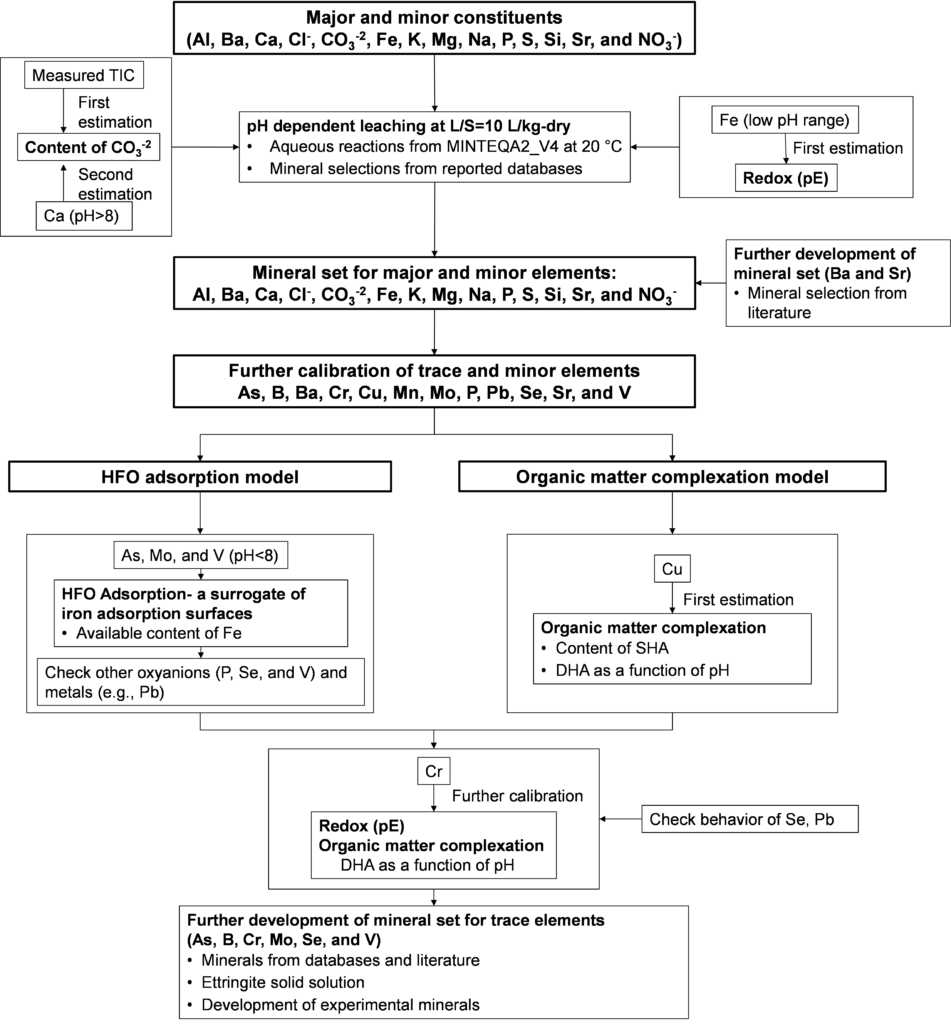
Figure 1: Comparison of geochemical modelling results of Ca, Cr, SO4 and V as a function of pH for fresh and carbonated cement mortar.
Application and uncertainty of a geochemical speciation model for predicting oxyanion leaching from coal fly ash under different controlling mechanisms, Xinyue Wang, Hans A. van der Sloot, Kevin G. Brown, Andrew C. Garrabrants. Zhiliang Chen, Bruce Hensel, David S. Kosson, Journal of Hazardous Materials, Volume 438, 15 September 2022, 129518.
As a starting point for the model calculations, the maximum value of release as obtained in the pH dependence leaching test (between pH 2 and 13) is used as the available solid phase concentration (i.e., available content, mg/kg dry weight basis). As the pH dependence test is carried out on separate sub-samples of sample to be tested, the variability in sub-sampling can be assessed from the analysis of non-reacting elements (e.g. Cl, Na, K) under conditions where interference from the eluant is not present (addition of acid or alkali for pH dependent leaching can interfere with either Na or K values). Basically, the speciation of all elements is calculated in one problem definition within the model with a common parameter set and values. This substantially limits the degrees of freedom in selecting parameter values, because improvement of the model description for one element may deteriorate the outcome for other elements.
The DOC analysis of the extracts does not directly represent the reactive part of the dissolved organic matter. Based on experience with other samples, where the relationship between hydrophilic, fulvic and humic acid fractions in DOC has been quantified, reactive fractions of DOC (dissolved humic acid – DHA) are defined as a function of pH (lowest proportion of reactive forms are in solution at neutral pH with increasing proportions towards both low and high pH). A polynomial fit is created through the data points to allow quantification of DHA at intermediate pH values in modelling. As Cu is the most sensitive element for particulate and dissolved organic matter interaction, the agreement between model and measurement of Cu is often used to fix the DHA/DOC ratio at different pH values. All other elements interacting with DHA are thereby fixed.
It was found that the leachable carbonate concentration is too low to describe the important role of carbonate in model calculations due to release of CO2 from solution during pH dependent testing at pH < 5. This parameter is therefore adjusted until Ca as calcite shows a good match with the observed leaching data. As all of the calcium carbonate and magnesium carbonate is dissolved at pH < 4, it is assumed that solid phase measurement of total inorganic carbon content (TIC) and also Thermogravimetric analysis/ Differential scanning calorimetry (TGA/DSC) can be used to estimate solid phase carbonate.
Since a wide range of materials have already been described (see case files of examples), the mineral phases that are allowed to precipitate can be selected from prior experience and adjusted as needed in an iterative process to provide a suitable description for all substances starting with major elements and then working towards trace elements.
Due to slow reaction kinetics, several clay minerals and rock phases are unsuitable phases in modelling. Furthermore, there often are significant differences between the primary minerals identified by XRD on bulk samples and the mineral and sorptive phases controlling leachability, which may be either trace phases or minor quantities present as coatings on particles. The selection of minerals and sorptive phases aims to describe the measured data well within one order of magnitude over as wide as possible pH range. Uncertainties in or lack of thermodynamic data for trace substances may limit this objective. The selected chemical speciation assemblage is not necessarily a unique solution, but rather the results should be considered in terms of its utility in representing the liquid-solid partitioning behaviour over a wide range of conditions (e.g., pH, L/S, batch and percolation column extractions, laboratory and field conditions) and therefore is useful in scenario and uncertainty analysis. The suitability of the resulting CSF can be further evaluated based on the ability to independently predict results from percolation column and monolith leach testing.
For modelling the column test results, the following percolation test parameters are needed in addition to the geochemical properties derived from the pH dependence test data: the initial pH from low L/S fractions of the percolation test, the porosity of the packed column, the density of the material, the height of the packed column and the eluant flow rate and composition (assumed constant for the duration of the laboratory test and simulation). The available contents as derived from the pH dependence test are used in modelling the percolation test results. Some variability in comparisons between pH dependence test results, percolation test results and model results can be caused by sub-sampling from the laboratory sample. By applying a limited number of cells over the length of the column (e.g., 5 cells), a certain level of dispersion is included in the model. A diffusion distance between stagnant and mobile zones is assumed, which is calibrated on the release of non-interacting elements (usually salts such as K, Na, Cl). Once this parameter is fixed, the initial pH is slightly adjusted to be able to predict the pH response as measured because the initial L/S from the column is substantially less than 10 (e.g., on the order of 0.2-0.6 mL/g dw). In the percolation model approach, local equilibrium dictated by the mineral and sorptive phases as determined from the modelling of the pH dependence test results is assumed. For the initial condition, concentrations throughout the column are assumed to be the same, which is in agreement with the pre-equilibration period of the column test. It is assumed that biodegradation is not leading to significant changes in the amount and type of particulate and dissolved organic matter phases during the short duration (<10 days) of the percolation test. The redox condition also is assumed not to change over the duration of the percolation test. However, materials with highly reactive organic matter (e.g. sludge amendment) may already show biological activity within 2 – 5 days. Normally, the eluant is demineralised water, which has very low concentrations of all substances in the materials. When soils and sediments are being tested, the use of 1 mM CaCl2 is recommended to prevent deflocculation of clays and organic matter. In case of reducing materials, care must be taken to exclude oxygen from entering the system and thus biasing the results. A prediction of DOC release from the organic matter content of the solid is not (yet) possible, and therefore the DOC data as measured in the percolation test is used in the simulation as input data. These data have been corrected to obtain the reactive fraction of DOC (DHA) relevant for metal interaction. A power function fit is used based on the equation: DHAL/S = q2 + q0*e (- q1*L/S), which gives at present a reasonable description for DHA at intermediate L/S values necessary for modelling.
The first step in the model calculations is to identify relevant solubility controlling mineral phases from pH dependent leaching test data from size-reduced monolithic samples. With the minerals identified through this process, the reactive organic matter, reactive Fe/Al-oxides and the element availability for leaching as input parameters, the CSF as input for modelling release from the monolithic products is obtained (hyperlink to References Zhiliang and Peng). In addition to the standard condition of L/S=10 in pH dependence, measurements at L/S=1 around the own pH of the material accounts for pore-water equilibration with mineral phases the may not be identified as important at L/S 10 because they completely dissolve at greater L/S but are solubility limited at low L/S.
Additional parameters for the modelling of release from monolithic products are: the dimensions of the specimen, one-sided or all sides release, the porosity, density, the degree of saturation (in the monolith leach test 100 %) and the tortuosity of the material. The latter value can be derived from the measurement of non-reactive components such as K, Na and Cl by comparing the calculated and measured release of relatively non-reactive components. In modelling monolithic specimen, one should be aware of changes in the surface layer of monolithic material due to exposure to atmospheric CO2 in storage, handling and also to a certain degree in testing. This aspect is highly relevant for alkaline materials, such as cementitious products.
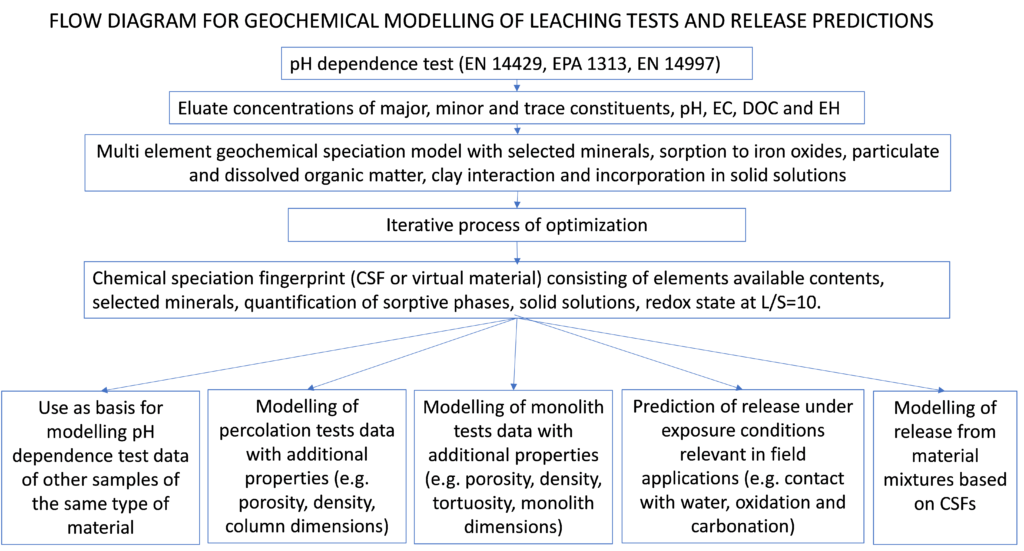
The role of natural organic carbon in leaching can be illustrated very well by the leaching behaviour of Cu from Municipal solid waste incinerator bottom ash. Cu is an element that has a very high affinity for the humic and fulvic acid fraction of dissolved organic matter. Due to incomplete combustion a residual amount of organic matter remains in MSWI bottom ash. Geochemical modelling shows the partitioning between mineral phases, particulate and dissolved organic matter interaction (figure 1).
When MSWI bottom ash is heated to 500 °C, the Cu leachability in the pH range 5 to 12 decreases orders of magnitude and at that point is fully controlled by an inorganic Cu mineral phase (Cu[OH]2). Upon addition of 1 weight percent of compost to the heated MSWI bottom ash sample the leachability of Cu increases in proportion to the increase of dissolved organic matter stemming from the compost (figure 2). A side effect of the heat treatment to eliminate the organic matter in MSWI bottom ash is the oxidation of part of the Cr to the more soluble chromate at pH 8 – 12.
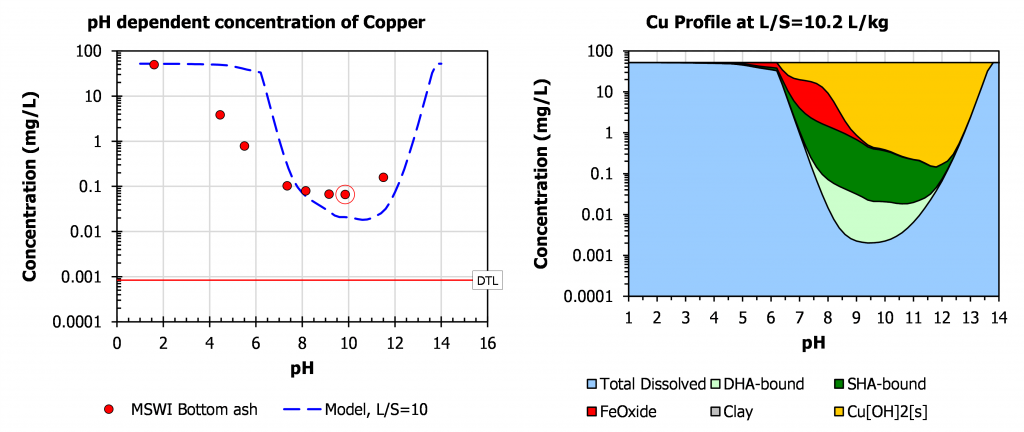
Figure 1. Geochemical speciation modelling of Cu leaching from MSWI bottom ash illustrating the role of minerals and organic matter interaction. Feoxide is hydrated ironoxide interaction; DHA is dissolved humic acid interaction; SHA is solid humic acid interaction; Clay represents clay interaction (negligible). The boken line in the left graph corresponds to the light green and dark green fields in the right graph.
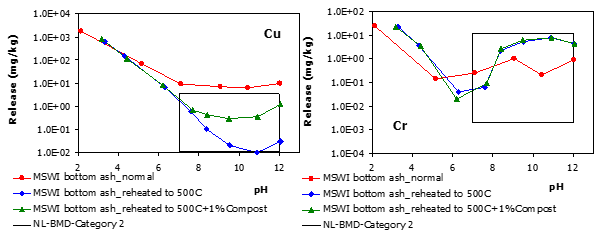
Figure 2. Effect of reduction of residual organic matter in MSWI bottom ash on Cu and Cr leaching and the consequences of the subsequent addition of compost to the heat-treated bottom ash.
What can be concluded from these observations is that mixing of MSWI bottom ash with compost of sewage sludge (proposed in recent studies), which are both very rich in dissolved organic matter, can lead to substantially increased concentrations of metals that are susceptible to interaction with the humic- and fulvic acid fractions of these materials. In case of very alkaline materials, the mobilisation of dissolved organic carbon (DOC) can be significant, as mobilisation of DOC increases with increasing pH.
All alkaline materials and products are subject to carbonation that results in a lowering of the pH with the consequence that leaching behaviour of elements can change. Substantial changes are particularly noted for oxyanions (AsO43-, BO33-, CrO42-, MoO4-2, Sb[OH]6–, SeO42-, SO42-, VO43-). In case of granular materials this process can proceed reasonably fast under moist unsaturated conditions. In the rate of carbonation particle size gradation is an important factor. In field applications already a significant level of carbonation can occur (e.g. road base application of recycled concrete aggregate). For monolithic products, the carbonation process creates a moving front that depends on the porosity and tortuosity of the product. The degree of saturation is also here an important controlling factor.
In figure 1 below the two left columns represent relatively fresh cement mortar, while the two left columns represent the same material after full carbonation. In the first column the leaching and full geochemical modelling results of Ca, Cr, SO4 and V are given as a function of pH. The own pH of the material is indicated by a circle around the corresponding measurement point. In the second column the partitioning of the dissolved and mineral phases is given. This illustrates the solubility controlling phases controlling leachability. The third column is the same as the first, but now for the fully carbonated material. Finally, the fourth column shows the partitioning after carbonation. The degree of carbonation is clear from the strong increase of calcite in the right set of graphs. Another feature is the dissolution of ettringite (SO4, Cr, V) as the pH in the carbonated sample drops to around 8.
In figure 2 the results of geochemical modelling are given when starting from the initial carbonate content of the material the carbonate level is increased until full carbonation is reached. This illustrates at what level of carbonation element retention by ettringite is fully lost.
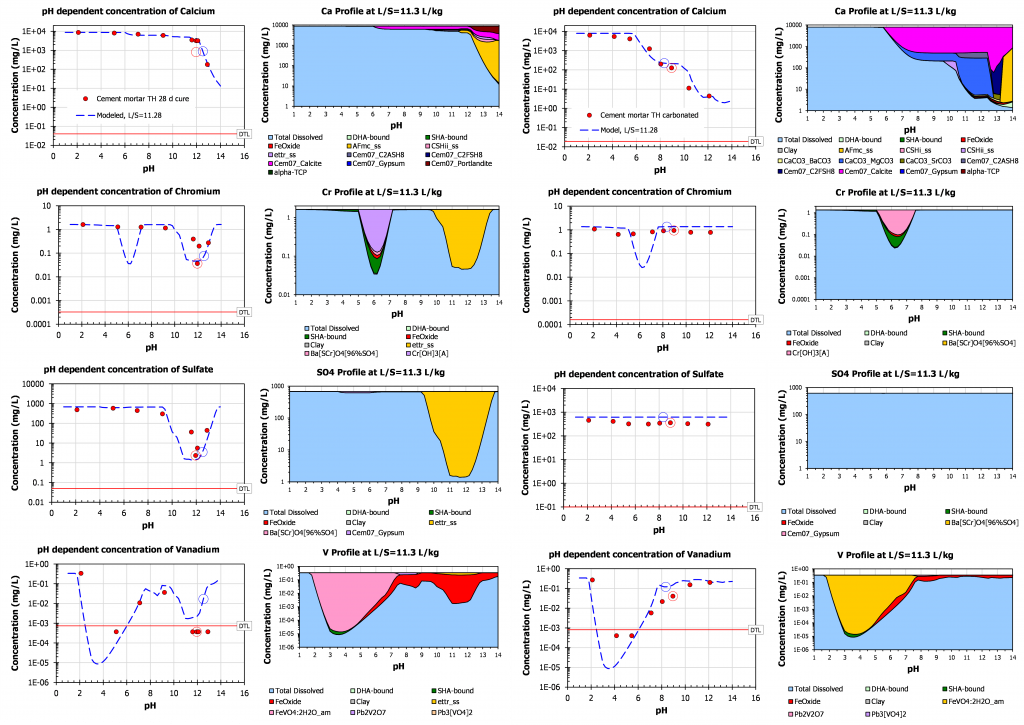
Figure 1.
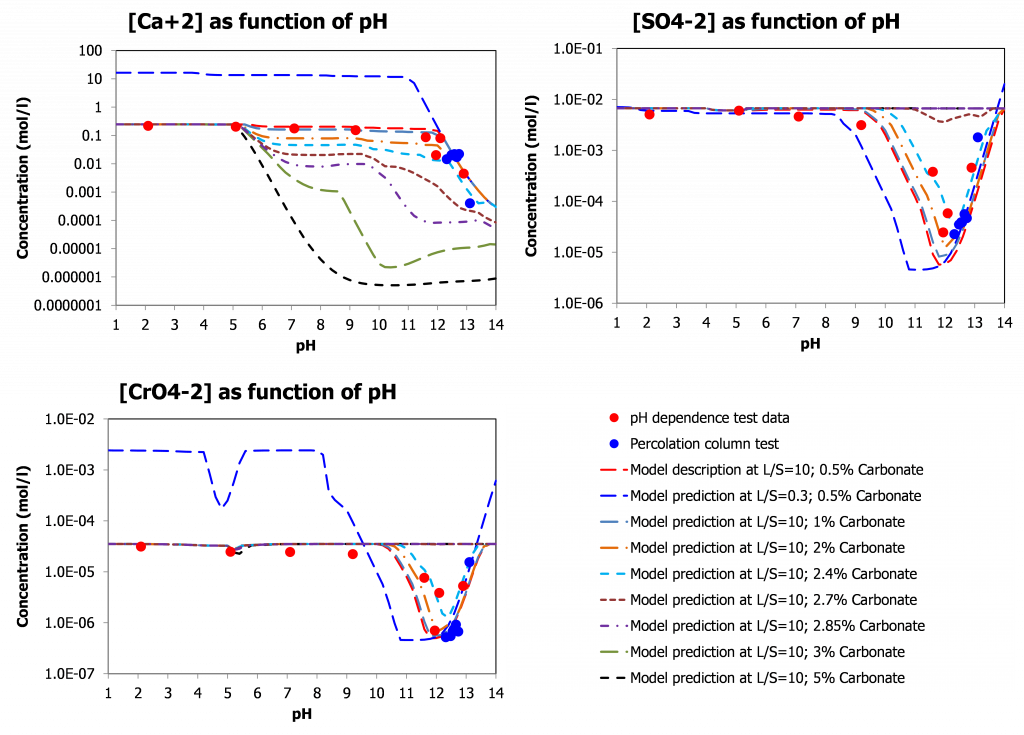
Figure 2. Modelling of element leaching behaviour in response to the carbonate level in the sample (amount in % of total d.m.). At 2.4 % carbonate all ettringite is dissolved.
Predicting release conditions outside the range of measured conditions – Redox
In laboratory leaching it is difficult to mimic realistic redox conditions in the field as any sample handling (e.g. size reduction) that is necessary for testing according to the standardised leaching protocols leads to a certain degree of sample oxidation which is difficult to avoid. Modelling of redox proves to be a viable option to address this limitation as shown below. In this case, test results obtained for municipal solid waste that was collected for a bioreactor study (ref Landgraaf) were used as basis for assessing the redox state under realistic MSW landfill conditions as derived from dissolved iron levels in leachates from a wide range of European MSW landfills. Fe(II) is more soluble than Fe (III) that is the main form under mildly reducing conditions (pH+pe=10). At a pH+pe < 5 pyrite is formed.
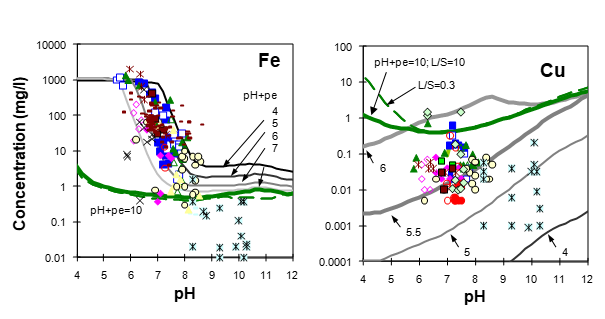
Modelling the Fe concentration in MSW leachate as a function of pH, redox state (pH+pe ranging from 13 to 3) and L/S = 10 was carried out. The thick green line is the laboratory test showing the mildly reduced sample conditions due to sample handling in the laboratory. Using the same chemical speciation fingerprint obtained for the partly oxidised MSW sample, the redox condition was modified by changing the pH+pe ratio to address real redox conditions in an MSW landfill derived from field leachate data. In parallel, the results for Cu leaching from MSW (thick grey line) are shown in comparison with leachate from many different MSW landfills (cluster of symbols ranging from pH 6 – 8.5) showing that the predicted Cu leaching at the intermediate redox condition derived from all landfill data (pe+pH around 5.5) matches quite well with dissolved Cu measurements in leachate. The light blue crosses are leachate data from MSW incinerator ash landfills (more alkaline), where almost all organic matter has been removed and as a result Cu leaching decreases to substantially lower concentration levels under mildly oxidised conditions.
This approach in testing and modelling was used to predict release from aged MSW landfills, when degradation of organic matter continues and dissolved organic carbon (DOC and thus the reactive fraction – dissolved humic acid – DHA) is reduced, which leads to less facilitated transport as DOC-complex (ref paper WM 2017).
Examples test data
Geochemical modelling
Source term definition